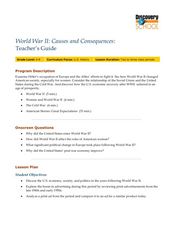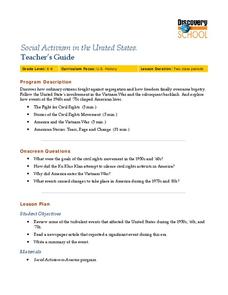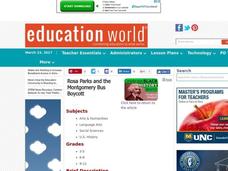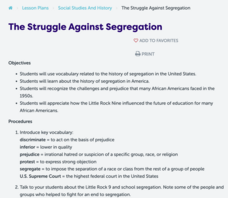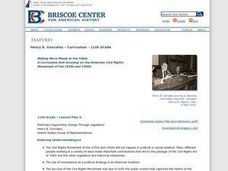National Endowment for the Humanities
"Sí, se puede!": Chávez, Huerta, and the UFW
"Sí, se puede!" Cesar Chavez and Dolores Huerta believed organizing farm workers and changing their working conditions were possible. Scholars examine provisions of the Bracero Program, videos, and the United Farm Workers' (UFW) work....
National Woman's History Museum
Gloria Steinem, Feminism and “Living the Revolution"
Excerpts from Feminine Mystique by Betty Friedan and from Gloria Steinem's "Living the Revolution" provide high schoolers an opportunity to study the feminism of the 1950s and 1960s, sometimes called the "Second Wave of Feminism."
Curated OER
American Pop Icons
Young scholars analyze art and decide if the images are an attempt to celebrate or criticize American Popular Culture of the fifties and sixties and discuss how successful "Pop Art" mirrored society. Students also discuss the difference...
Curated OER
1950's Popular Culture
Students gain a basic understanding of Capitalism and Communism, the ideologies that fueled the United States and the Soviet Union during the Cold War.
Curated OER
Baby Boom and the Culture of the 1950's
Eleventh graders explain the causes, course, and consequences of the United States' role in World War II.
Curated OER
Jazz In America - Lesson Plan 6
Fifth graders explore cool jazz and how it reflected American culture in the 1940's and 1950's.
Curated OER
"The New Television Set" a Gateway to the Post World War II Era
Eleventh graders demonstrate their knowledge of the effects of television on the political, economic, religious, social, intellectual and artistic life of the US nation from the 1950's. Research how television shaped public opinion with...
Curated OER
World War II: Causes And Consequences
Middle schoolers discuss the U.S. economy, society, and politics in the years following World War II. They explore the boom in advertising during this period by reviewing print advertisements from the late 1940s and early 1950s. ...
Curated OER
Social Activism in the United States
Seventh graders explore the goals of the Civil Rights Movement of the 1950s and 1960s. In this US History lesson, 7th graders read a newspaper article that reported a significant event during this era. Students write a summary of this...
Curated OER
Building Suburbia: Highways and Housing in Postwar America
Students determine how suburbs changed America. In this post World War II lesson, students complete research projects that require them to examine the growth of suburbs in the 1950's and 1960's. Students reveal how government policies,...
Curated OER
What is the Risk?
Students investigate the 1950's pollution tragedy in Minamata, Japan. The elements of dose, response, individual susceptibility, potency, and threshold of toxicology are explored in this lesson.
Curated OER
Rosa Parks and the Montgomery Bus Boycott
Students dramatize incident that started the civil rights movement of the 1950s and 1960s: Rosa Parks's refusal to give up her seat on a bus in Montgomery, Alabama.
Curated OER
The Struggle Against Segregation
Students use vocabulary related to the history of segregation in the United States. They study about the history of segregation in America and recognize the challenges and prejudice that many African Americans faced in the 1950s....
Curated OER
Salem Witch Trials
Students consider the implications of the Salem Witch Trials. In this literature lesson plan, students read Arthur Miller's The Crucible and compare the witch trials to McCarthyism of the 1950's. Students rewrite scenes from the play...
Council for Economic Education
A Lesson on the Supply and Demand of Toy Fads
Let's all Hula Hoop! Scholars research the supply and demand side of toy fads in the United States. They analyze video clips and news articles to complete graphs on how the supply curve slope works in concert with the demand for products...
Curated OER
American Economics after WWII
Students analyze the American culture after WWII. Through a variety of activities, students gain an understanding of ecomonics and prosperity in the US following WWII.
Curated OER
Making More Places at the Table: The American Civil Rights Movement of the 50's and 60's
Eleventh graders examine the biography of Henry B. Gonzalez. They examine primary source documents from Congressman Gonzalez's personal papers related to his contributions to the Civil Rights Movement.
Curated OER
On the Air
Students explore the issue of race in television since the 1950's, focusing specifically on African-American entertainers. After researching important issues, events, and television personalities of specific decades, students create TV...
Facing History and Ourselves
Emmett Till: Connecting the History of Lynching to The Murder
Though the murder of Emmett Till shocked 1950's America into turning attention to the racial crimes of the South, it was far from the first time racism had erupted into violence. High schoolers examine the killing in context with the...
Curated OER
Rosa Parks Changed the Rules
Students listen to a story about Rosa Parks and examine the bus seating rules of the 1950s. In this civil rights movement activity, the teacher reads students a book about Rosa Parks, then students complete a worksheet with a diagram of...
Curated OER
Romare Bearden's The Dove - A Meeting of Vision and Sound
Students explore African american culture of the late 1950's and 60's through various primary sources including literature, music, art and others. They then prepare and conduct a mock interview and present with the class.
Curated OER
Nonviolence as a Tool for Change Lesson 1
Students examine voting rights in the South during the 1950s and 1960s. In this civil rights lesson, students examine legal rights and the opportunity to cast votes. Students research primary documents regarding the topic and share their...
Curated OER
A Picture's Worth a Thousand Words
Students analyze the numbers of male vs female administrators and teachers from their school. In this gender equality lesson plan, students use school yearbooks from the 1950's threw present to count how many male vs. female teachers,...
Curated OER
Consumer Culture in the 1950s: New Shopping Centers and Advertising trends
Learners examine the effect of suburbs on American cities. They identify the changes the cities had to face after people moved elsewhere. Using primary source ads, they compare them with contemporary ads and discuss what can be found out...
Other popular searches
- U.s. History 1950's
- 1950's Music
- 1950s Rock and Roll
- 1950's Lifestyle
- 1950's Clip Art
- 1950s Pop Culture
- Red Scare 1950's
- 1950s Activities
- 1950s Culture
- 1950's America
- Consumerism in the 1950's
- 1950s Social Studies









